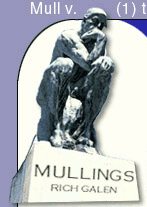|
|

|

Novus Ordo Seclorum
 Thursday, July 5, 2001
Thursday, July 5, 2001
- The 56 men who signed the Declaration of Independence, to which they pledged "our Lives, our Fortunes and our sacred Honor," are well known to us. The great swirling signature of John Hancock, as an example, has caused many a young boy to go home and practice his cursive for as long as several minutes, before deciding stickball was a faster route to fame and fortune than good handwriting.
- There is a 57th name attached to the Declaration: Charles Thomson. Mr. Thomson was the Secretary of the Continental Congress. He attested to the signatures of the 56 so if, as Benjamin Franklin warned, they must "hang together or we will surely hang separately," then there would have been a space on the gallows for Charles Thomson.
- In fact, the document which was printed on July 4, 1776 (printed by John Dunlap) was signed by only Hancock and Thompson. That copy has been lost, but copies of the 500 broadsides which were printed show only those two.
- The rest of the signatures were put on the Declaration on August 2, 1776 which resulted in the document we know today.
- After keeping track of the goings-on in Philadelphia in the summer of 1776 (he served as Secretary until 1789), Thomson was given the task of designing the Great Seal of the United States in 1782.
- It was Thomson, who had been a Latin instructor prior to being the headmaster of the Congress, who came up with not the uno, not the two, but the three mottos which grace the Great Seal.
- It will be helpful, here, if you reach into your wallet and pull out a one dollar bill. Turn it over. There you see the two sides of the Great Seal of the United States which we know because it says: "The Great Seal" under one side and "Of the United States" under the other - even though the Eagle is usually portrayed as the front and the Pyramid as the back.
- If you don't have any smaller than a 20, you can see the Great Seal in enough detail to follow along on
the Secret Decoder Ring page.
- E Pluribus Unum - Out of Many, One - is the best known motto and, if you're like me, until yesterday, the ONLY known motto. This appears on the streamer the eagle holds in its mouth.
- Everybody knows "E Pluribus Unum." It graces our every day speech with a sense of classic thought. Which of us, at a baseball game for instance, when the opposition has none out and the bases loaded, has not prayed for a grounder to short so a double play would result in two outs and only one man on base after which we shout: "E Pluribus Unum!" pumping our fists in the air.
- Me, too. And let me tell you, the guys immediately in front ALWAYS turn around and stare at me with great admiration in their eyes. At least I think that's great admiration.
- Anyway, Mr. Thomson added the phrase "Annuit Coeptis" surrounding the Eye of Providence atop the pyramid. This translates generally to "It [the eye of providence] has favored our undertakings."
- You might try uttering that next time you go into your boss' office to ask for a raise.
- The base tier of the pyramid has the date, MDCCLXXVI, around which Thomson's third motto "Novus Ordo Seclorum" (A New Order of the Ages) appears.
- There are, by the way, 13 tiers that make up the unfinished pyramid, as there are 13 stars above the eagle's head, thirteen leaves on the olive branch in its right claw, and thirteen arrows in its left.
- Thomson wrote he had placed "Novus Ordo Seclorum" under the date, 1776, to signify "the beginning of the new American era, which commences from that date."
- But that is only because Mr. Thomson could not possibly have known that the continuing influence July 4, 1776
would have on the planet Earth over the 225 years since he oversaw its signing.
- Last factoid: The signed document does not contain Thomson's name. You can hear the discussion echoing among the Members of the Continental Congress lo these many years hence:
"Shouldn't we have Charles Thomson sign?"
"Nah. Staff."
-- END --
Copyright © 2001 Richard A. Galen


Current Issue |
Secret Decoder
Ring | Past
Issues | Email
Rich | Rich
Who?
Copyright �1999 Richard
A. Galen | Site design by Campaign
Solutions. | |
|

